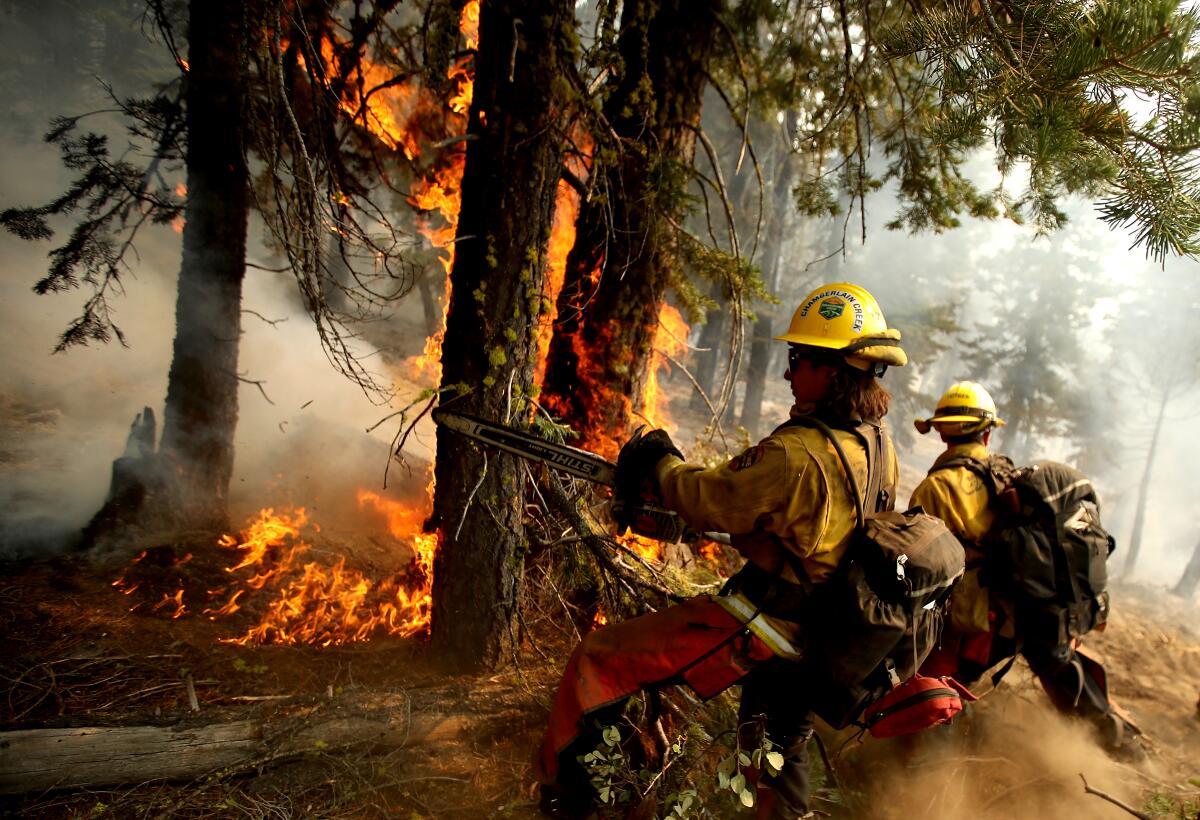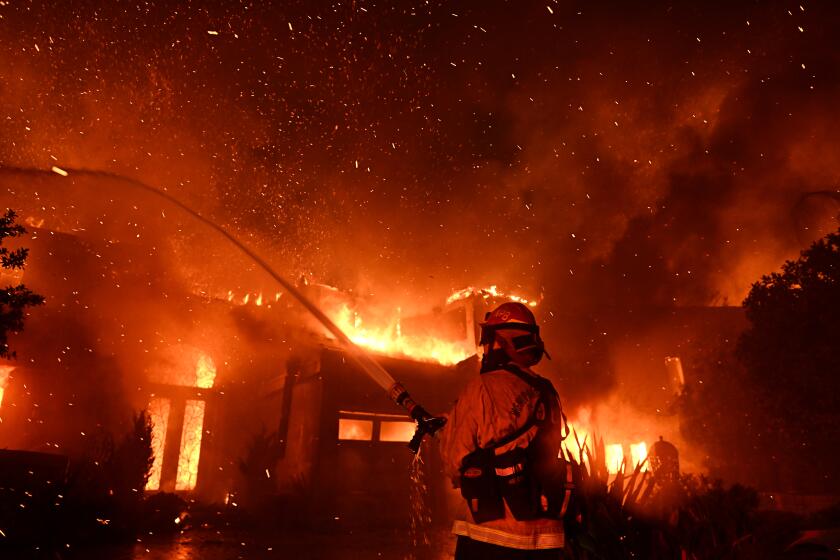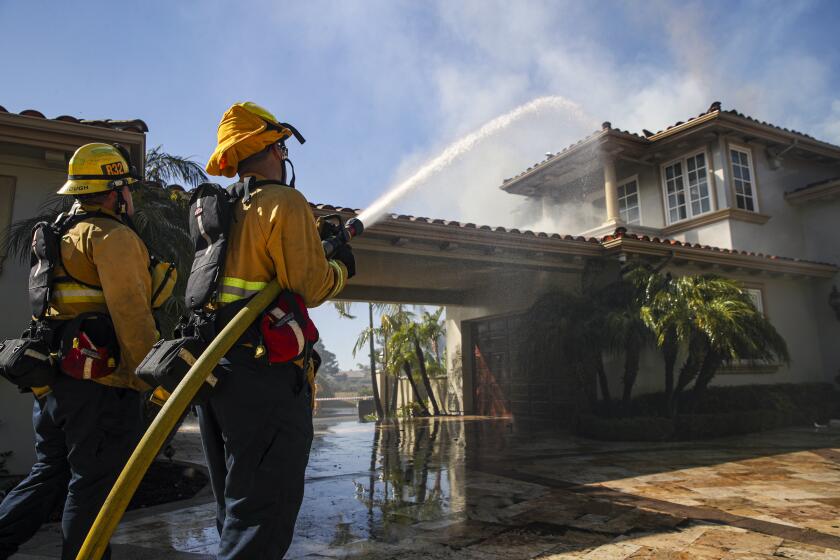A treacherous California fire season made more dangerous by drought, water restrictions

- Share via
Southern California is facing a potentially treacherous wildfire season this year, as climate change, drought and extreme heat conspire to bake vegetation and prime the landscape for burning, officials say.
Standing beneath the blazing sun at the start of a triple-digit heat wave, fire officials from various state, county and federal agencies gathered in Los Angeles on Thursday to warn residents about the current conditions and what the coming months may hold.
“We know the drought is here. We know the fuels are flammable. We know now, with water restrictions, the vegetation around our homes are becoming flammable,” said Dustin Gardner, chief of the Ventura County Fire Department. “So we know the threat is here, and we know the threat is real.”
Officials in recent years have been sounding the alarm about the state’s changing conditions, with wildfires across the West growing hotter, faster and harder to fight due to increasing heat and dryness. Last year, more than 2.5 million acres burned in California — including the 960,000-acre Dixie fire, the state’s second-largest blaze on record.

This year, fuel moisture levels — or the amount of water in the vegetation — is at least four months ahead of where it should be in terms of dryness, officials said. In some cases, fuels are 40% drier than on this same day in 2016, which was, at the time, among the driest they’d ever seen.
“We’re seeing it year after year for the last few years,” Gardner said. “We’re getting hotter, drier, faster.”
National Weather Service warns of dangerously hot conditions this weekend, with triple-digit temperatures from Sacramento to Borrego Springs.
The warning comes as much of California heads into a dangerous heat wave, with temperatures predicted to soar as high as 106 degrees in Sacramento on Friday and 117 in Borrego Springs Saturday. Last year, a similar June heat wave helped kick off Northern California’s fire season with the Sugar and Beckwourth Complex fires.
After the driest-ever January, February and March, nearly all of California is classified under severe, extreme or exceptional drought, according to U.S. Drought Monitor.
Kristina Dahl, principal climate scientist at the Union of Concerned Scientists, said the confluence of hazards is transforming summer into “danger season” in the U.S.
“What we see is when snowpack gets very low in spring, we tend to have a little more fire activity in the subsequent wildfire season,” she said. “And we also know that when it’s exceptionally warm, we’re more likely to see drier conditions because heat can exacerbate drought conditions and make them worse.”
Increased fire activity also means the increased probability of flames where people live, Dahl said, particularly as more people move into the area known as the wildland-urban interface.
Already this year, more than 2,000 fires have burned about 11,000 acres in the state, according to the California Department of Forestry and Fire Protection. In May, the devastating Coastal fire in Orange County destroyed an estimated 20 homes.
That that blaze ignited on a “normal day” only exemplified the region’s growing risk, said Orange County Fire Authority Chief Brian Fennessy.
“That was not a Santa Ana day, the humidity was more than 70%, the temperatures were in the mid-70s,” he said. “The big difference is the fuels ... That vegetation was dry.”
Fennessy said conditions are likely to only worsen as the state heads into what is typically the hottest, driest part of the year.
“It’s climate change,” he said. “I’m not a scientist, but I’ve been doing this 40-plus years, and I’ve never seen fire spread the way it is. I’ve never seen what we’re experiencing today.”
Just three hours after a small fire was reported in Aliso Woods Canyon, at least a dozen homes were ablaze.
The fire chiefs on Thursday stressed the need for the public’s cooperation heading into the summer, particularly when it comes to proactive measures such as brush clearance, or the removal of flammable materials from around homes to help create a defensible space.
“It’s that lower vegetation that we want cleared because that’s what’s going to spread a wildfire,” said Capt. Erik Scott of the Los Angeles Fire Department. “It’s what we often refer to as a fire ladder: It’ll start on the ground, it’ll start to spread up those trees, especially through the dry or dead vegetation, and then it’ll be caught by the winds, and that’s where embers get spread.”

Los Angeles County Fire Department Chief Daryl Osby said the agencies are also “looking at the science of fires” to reevaluate guidelines for vegetation and are working to augment their firefighting staff, particularly in wind-prone areas where blazes can grow quickly out of control.
Additionally, the region’s fire departments are pursuing local and statewide fuel mitigation projects, Osby said, including the use of goats to maintain fire-prone vegetation as well as mechanical thinning and potentially controlled burns.
Orange, Los Angeles and Ventura counties are also securing additional firefighting helicopters for standby to help drop water and retardant onto flames, he said.
Some water districts say new drought restrictions raise wildfire risks. They are demanding that the state give them more water for outdoor irrigation.
But individual agencies are often no match for the new breed of wildfires, officials said.
“These major wildland fires are so large, so destructive, that no fire department can handle it on their own, so the call for mutual aid goes out literally on a daily basis,” said Brian Marshall, fire and rescue chief with the California Governor’s Office of Emergency Services. During the last fiscal year, the state’s wildfire suppression costs ballooned beyond $1.1 billion.
Osby said current conditions, including the drought, will undoubtedly make it harder to fight fires this year. Crews have pre-identified water sources in Los Angeles County where aerial crews can fill their tanks, he said, and they will also lean heavily on retardant and foam.
Dahl, the scientist, said the climate trends driving worsening fires are expected to continue to varying degrees, depending on how quickly we can cut heat-trapping emissions from fossil fuels.
“The more effectively we can cut those emissions and the more quickly we can cut those emissions, the less we will see the growth of wildfires in the state,” she said.
But when it comes to the 2022 season in Southern California, officials made it clear the writing is on the wall.
“Given the fuel conditions, the fire conditions that we’re here talking about, I foresee a very tough four, five, six months in front of us,” Fennessy said.
More to Read
Sign up for Essential California
The most important California stories and recommendations in your inbox every morning.
You may occasionally receive promotional content from the Los Angeles Times.















